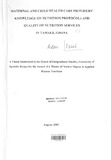| dc.description.abstract | The purpose of this study was to determine accessibility of protocols, MCH service
providers' knowledge on nutrition protocols and the quality and adequacy of nutrition
actions they deliver in order to generate ideas and make recommendations that would
improve nutrition component actions in MCH services in Tamale, Ghana.
A cross sectional assessment ofMCH care providers' in government health care delivery
institutions within and surrounding communities of Tamale was conducted. The target
populations were the health care providers' and their clients' (pregnant and lactating
women and young children). A simple random process was used to select 41 service
providers and 28 health facilities across the six sub-districts of Tamale.
Tools used in data collection were set of questionnaires, structured observation guides,
and checklists on nutrition supplies available compared to the recommended amounts per
service contact.
Findings from the study revealed that the mean nutrition protocols accessible to service
providers was 2.8, and ranged from 1 to 5. About 57.5% of service providers had access
to adequate number of protocols whilst 42.5% had inadequate protocols. The mean
protocol knowledge score was 15.1, which ranged from 4.5 to 25.5. In all, 44% and 56%
respectively of service providers had low and high knowledge on protocols. The mean
quality service score was 62.49, and ranged from 34 to 91.67. 63% and 37% of service
providers delivered high and low quality nutrition services respectively. The distribution
of service providers between the two levels of protocols accessibility, knowledge and
quality of nutrition services were all statistically insignificant. However, the distribution
of service providers delivering adequate and inadequate nutrition services was si~iticant
ix
(Chi-Square statistic 7.049, p = 0.008), A Likelihood ratio Chi-Square test between the
associations of knowledge to the category of service providers' was significant (11.463, p
;: 0.003). There were significant correlations between service providers' knowledge and
quality of nutrition services (0.645, p < 0.05); and between service providers' knowledge
and adequacy of nutrition services (0.353, p = 0.024). Also significant was a correlation
'1
between service providers' years of practice and quality of nutrition services (0.654, p <
0.05).,No significant association was found between the categories of service providers'
and quality of nutrition services.
Based on the study findings, the hypothesis that 'there is no significant difference in the
quality of nutrition services between rural and urban health facilities' cannot be rejected.
However, two hypotheses namely: 'Service providers' knowledge on protocols is not
significantly associated with the quality of services'; and Service providers' years of
practice have no significant effect on the service quality' are both rejected.
In conclusion, protocols accessibility was adequate since more majority (57.7%) had
access to adequate number of protocols. But the protocols were poorly distributed among
the different categories of service providers. Community Health Nurses had very limited
access to a variety of nutrition protocols even though they made contacts with the highest
number of clients compared to Nurse-Midwives or Staff Nurses. There was inadequate
knowledge on service protocols by service providers. Slight variation was observed in the
proportions of knowledgeable service providers between the urban and rural health
facilities. Nevertheless, that did not significantly affect quality service delivery between
the two settings. However overall, there was low delivery of quality nutrition services.
Factors that hindered service providers' from using protocols were inadequacies of
x
nutrition supplies service providers' poor knowledge on protocols and clients' noncompliance
to treatment protocols.
Some recommendations generated following the study findings are:
l} Higher priority should be given to Community Health Nurses in the distribution
'1
nutrition protocols.
2) Distribution of nutrition supplies should be consistently monitored.
3)" Forums should be created to enable service providers' opportunity discuss and
share knowledge and information on current service delivery practices.
4) When planning and organizing in-service trainings, Community Health Nurses
should be top priority. | en |

